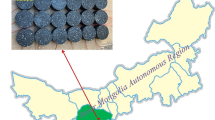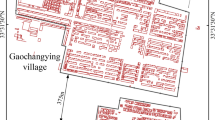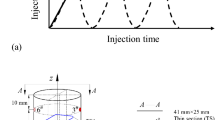Abstract
Coal seam water injection is a critical measure for the prevention of coal-and-gas outbursts. However, the gas–solid–liquid coupling effect in front of the working face before and after water injection during coal mining is scarcely investigated. This issue was explored in this study by (a) numerical simulation of stress, gas pressure, and water saturability distribution as well as their coupling effect in front of the working face via the proposed multi-field coupling model run in the COMSOL software and (b) comparative analysis of the above parameters before and after water injection. During coal mining, stress in front of the working face first increased and then dropped to the initial value as the distance from the coal wall increased, while gas pressure exhibited a similar distribution pattern. After water injection, the stress distribution pattern remained almost unchanged, but the stress peak shifted forward, the stress relief zone broadened, while the gas pressure around the borehole dropped. In particular, the gas pressure in front of the borehole increased slightly at the beginning of water injection. As water was permanently injected, the gas pressure in front of the borehole decreased, while that around the borehole further decreased. Meanwhile, the water saturability of the coal seam around each borehole increased, with a ring-shaped distribution pattern. Due to the interaction of water injection among multiple boreholes, the contour lines of water saturability showed semi-circular distribution patterns around multiple boreholes.











Similar content being viewed by others
References
Adenutsi, C. D., Li, Z., Aggrey, W. N., & Toro, B. L. (2018). Performance of relative permeability and two-phase flow parameters under net effective stress in water wet porous media: A comparative study of water–oil versus silica nanofluid–oil. Arabian Journal for Science and Engineering., 43(11), 6555–6565.
Chen, S., Yang, T., Ranjith, P. G., & Wei, C. (2017). Mechanism of the two-phase flow model for water and gas based on adsorption and desorption in fractured coal and rock. Rock Mechanics and Rock Engineering, 50(3), 571–586.
Chen, Y., Xu, J., Peng, S., Yan, F., & Fan, C. (2018). A gas–solid–liquid coupling model of coal seams and the optimization of gas drainage boreholes. Energies, 11(3), 560.
Chen, Z., Pan, Z., Liu, J., Connell, L. D., & Elsworth, D. (2011). Effect of the effective stress coefficient and sorption-induced strain on the evolution of coal permeability: experimental observations. International Journal of Greenhouse Gas Control, 5, 1284–1293.
Cheng, W., Liu, Z., Yang, H., & Wang, W. (2018). Non-linear seepage characteristics and influential factors of water injection in gassy seams. Experimental Thermal and Fluid Science, 91, 41–53.
Cheng, W., Nie, W., Zhou, G., Yu, Y., Ma, Y., & Xue, J. (2012). Research and practice on fluctuation water injection technology at low permeability coal seam. Safety Science, 50(4), 851–856.
Fan, C., Li, S., Elsworth, D., Han, J., & Yang, Z. (2020). Experimental investigation on dynamic strength and energy dissipation characteristics of gas outburst prone coal. Energy Science & Engineering, 8(4), 1015–1028.
Fan, C., Luo, M., Li, S., et al. (2019a). A thermo-hydro-mechanical-chemical coupling model and its application in acid fracturing enhanced coalbed methane recovery simulation. Energies, 12, 626.
Fan, J., Chen, J., Jiang, D., Wu, J., Shu, C., & Liu, W. (2019b). A stress model reflecting the effect of the friction angle on rockbursts in coal mines. Geomechanics and Engineering, 18(1), 21–27.
Hao, D., Zhang, L., Ye, Z., Tu, S., & Zhang, C. (2018). Experimental study on the effects of the moisture content of bituminous coal on its gas seepage characteristics. Arabian Journal of Geosciences , 11, 436.
Jiang, J., Cheng, Y., Mou, J., Jin, K., & Cui, J. (2015). Effect of water invasion on outburst predictive index of low rank coals in dalong mine. PLoS ONE, 10(7), e0132355.
Kong, X., Wang, E., Liu, Q., Li, Z., Li, D., Cao, Z., et al. (2017). Dynamic permeability and porosity evolution of coal seam rich in CBM based on the flow-solid coupling theory. Journal of Natural Gas Science and Engineering, 40, 61–71.
Li, S., Fan, C., Han, J., Luo, M., Yang, Z., & Bi, H. (2016). A fully coupled thermal-hydraulic-mechanical model with two-phase flow for coalbed methane extraction. Journal of Natural Gas Science and Engineering, 33, 324–336.
Lin, B., Zhou, S., & Zhang, R. (1993). The stress relaxation zone in coal tunneling and its application to forecast of outburst danger. Journal of China University of Mining and Technology, 22(4), 44–52.
Liu, H., & Rutqvist, J. (2010). A new coal-permeability model: internal swelling stress and fracture-matrix interaction. Transport in Porous Media, 82(1), 157–171.
Liu, Q., Cheng, Y., Zhou, H., Guo, P., An, F., & Chen, H. (2015). A mathematical model of coupled gas flow and coal deformation with gas diffusion and klinkenberg effects. Rock Mechanics and Rock Engineering, 48(3), 1163–1180.
Liu, T., Lin, B., & Yang, W. (2017). Coal permeability evolution and gas migration under non-equilibrium state. Transport in Porous Media, 118, 393–416.
Meng, S., Li, Y., Wang, L., Wang, K., & Pan, Z. (2018). A mathematical model for gas and water production from overlapping fractured coalbed methane and tight gas reservoirs. Journal of Petroleum Science and Engineering, 171, 959–973.
Meng, Z., Shi, X., & Li, G. (2016). Deformation, failure and permeability of coal-bearing strata during longwall mining. Engineering Geology, 208, 69–80.
Ni, G. H., Dong, K., Li, S., & Sun, Q. (2019). Gas desorption characteristics effected by the pulsating hydraulic fracturing in coal. Fuel, 236, 190–200.
Perera, M. S. A., Ranjith, P. G., & Peter, M. (2011). Effects of saturation medium and pressure on strength parameters of latrobe valley brown coal: Carbon dioxide, water and nitrogen saturations. Energy, 36(12), 6941–6947.
Poulsen, B., Adhikary, D., & Guo, H. (2018). Simulating mining-induced strata permeability changes. Engineering Geology, 237, 208–216.
Rod, K. A., Um, W., Colby, S. M., Rockhold, M. L., Strickland, C. E., Han, S., et al. (2019). Relative permeability for water and gas through fractures in cement. Plos One, 14(1), e210741.
Shen, J., Qin, Y., Li, Y., & Wang, G. (2019). Experimental investigation into the relative permeability of gas and water in low-rank coal. Journal of Petroleum Science and Engineering, 175, 303–316.
Wang W., Wang H., Li D., Li H., & Liu Z. (2018). Strength and failure characteristics of natural and water-saturated coal specimens under static and dynamic loads. Shock and Vibration, 3526121.
Xie, G., Hu, Z., & Wang, L. (2014). Coupling effect of coal seam gas pressure and mining stress. Journal of China Coal Society, 39(06), 1089–1093.
Xu, H., Tang, D., Zhao, J., Li, S., & Tao, S. (2015). A new laboratory method for accurate measurement of the methane diffusion coefficient and its influencing factors in the coal matrix. Fuel, 158, 239–247.
Xu, H., Tang, D., Tang, S., Zhao, J., Meng, Y., & Tao, S. (2014). A dynamic prediction model for gas–water effective permeability based on coalbed methane production data. International Journal of Coal Geology, 121, 44–52.
Yang, W., Wang, H., Zhuo, Q., Lin, B., Zhang, J., Lu, C., et al. (2019). Mechanism of water inhibiting gas outburst and the field experiment of coal seam infusion promoted by blasting. Fuel, 251, 383–393.
Yin, G., Jiang, C., Xu, J., Guo, L., Peng, S., & Li, W. (2012). An experimental study on the effects of water content on coalbed gas permeability in ground stress fields. Transport in Porous Media, 94(1), 87–99.
Zhai, C., Xiang, X., Xu, J., & Wu, S. (2016). The characteristics and main influencing factors affecting coal and gas outbursts in Chinese Pingdingshan mining region. Natural Hazards, 82(1), 507–530.
Zhang C., Wang E., Xu J., et al. (2020a). A new method for coal and gas outburst prediction and prevention based on the fragmentation of ejected coal. Fuel, 119493.
Zhang, C., Wang, E., Xu, J., et al. (2020). Research on temperature variation during coal and gas outbursts: Implications for outburst prediction in coal mines. Sensors, 20(19), 5526.
Zhang, R., Cheng, Y., & Yuan, L. (2019). Study on the stress relief and permeability increase in a special low-permeability thick coal seam to stimulate gas drainage. Energy Sources Part A- Recovery Utilization and Environmental Effects, 8(42), 1001–1013.
Zhao, D., Feng, Z., & Zhao, Y. (2011). Experimental study on the effect of high pressure water injection on the desorption characteristics of coal gas. Chinese Journal of Rock Mechanics and Engineering, 30(03), 547–555.
Zhao, J., Tang, D., Xu, H., Meng, Y., Lv, Y., & Tao, S. (2014). A dynamic prediction model for gas-water effective permeability in unsaturated coalbed methane reservoirs based on production data. Journal of Natural Gas Science and Engineering, 21, 496–506.
Zhao, Y., Cao, S., Li, Y., Yang, H., Guo, P., Liu, G., et al. (2018). Experimental and numerical investigation on the effect of moisture on coal permeability. Natural Hazards, 90(3), 1201–1221.
Acknowledgments
This study was financially supported by Langfang science and technology research and development project (2020013032), University Science and technology research project of Hebei Province (QN2020524), National Natural Science Foundation of China (51774114), Fundamental Research Funds for the Central Universities (3142019004, 3142018028) and Natural Science Foundation of Hebei Province in China (E2019508124, E2019508100)
Author information
Authors and Affiliations
Corresponding authors
Rights and permissions
About this article
Cite this article
Chen, Y., Chu, T., Chen, X. et al. Comparative Analysis of Gas–Solid–Liquid Coupling Behavior in Front of the Working Face Before and After Water Injection During Coal Mining. Nat Resour Res 30, 1561–1575 (2021). https://doi.org/10.1007/s11053-021-09816-6
Received:
Accepted:
Published:
Issue Date:
DOI: https://doi.org/10.1007/s11053-021-09816-6




